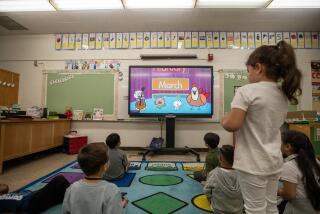Smaller Classes Reaped Benefits, Simi Poll Shows
- Share via
Students’ behavior and motivation improved last year in grades one through three because of smaller class sizes, according to a survey administered by the Simi Valley Unified School District.
Better student-teacher communication also was cited in a report based on surveys last winter of 288 parents, 78 teachers and 19 elementary principals. All answered basic questions on class-size reduction in the nearly 19,000-student district for the 1996-97 school year.
The results were compiled by Karen Dubrule, the district’s director of elementary education, and released last week.
Contrasted with a year earlier, most parents said the individual attention from teachers toward their children improved, verbal encouragement increased, attention was shifted to instruction rather than focusing on behavior problems, and more hands-on activities were created because of the smaller class sizes.
“I think [class-size reduction] is wonderful,” one parent wrote. “The kids and teachers develop a faster and stronger bond. This greatly enhances learning and teamwork. The smaller size of my child’s class enables them all to become a real team. Most of the time nobody was left out. They were all friends and really helped each other.”
The survey, however, showed parental involvement in the school district had not increased because of class-size reduction. But principals said in their survey that parents have always had a high participation level.
Among the responses from the teachers, about 80% of whom had less than 20 students:
* Nearly all (95%) said they were more likely to talk one-on-one with students.
* Nearly three-fourths (72%) said the most beneficial aspect of class-size reduction was individual attention.
* More than two-thirds (68%) said they were able to initiate enrichment activities for students.
* More than half (60%) predicted students would gain better academic skills if class-size reduction continues.
All 19 principals except one, who indicated there had not been a change, said student behaviors improved with reduced class sizes.
Respondents did cite some negative aspects of class-size reductions.
Teachers complained of limited classroom space, lack of supplies and lack of funding. Some also said most of the physical moves to set up the new classrooms were done by staff members.
Many principals wrote that the late implementation of class-size reduction caused some poor planning and that some of the teachers were hired in a rush without the appropriate skills.
Others said leaving kindergarten out of the class-size reduction move was a mistake.
One principal wrote, “The fact that we implemented third grade as opposed to kindergarten created more problems philosophically and morale was low among kindergarten teachers.”
Wrote another: “The transition from grade three to four was a major leap.”
Dubrule said she would recommend at the next school board meeting that kindergarten be included in class-size reduction next year.
More to Read
Sign up for Essential California
The most important California stories and recommendations in your inbox every morning.
You may occasionally receive promotional content from the Los Angeles Times.













